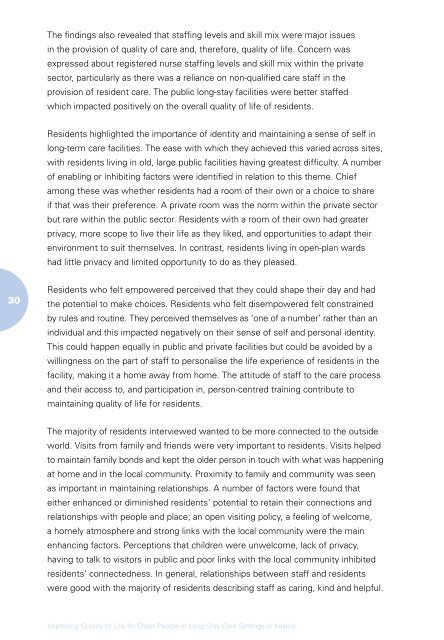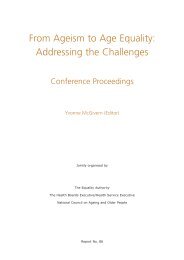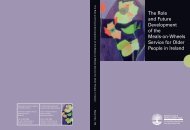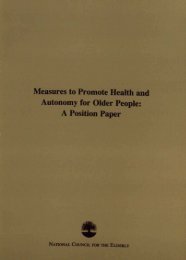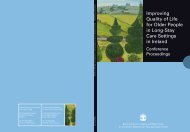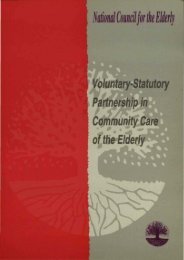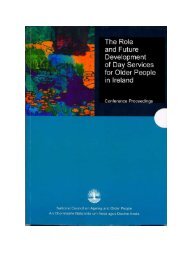Improving Quality of Life for Older People in Long-Stay Care ...
Improving Quality of Life for Older People in Long-Stay Care ...
Improving Quality of Life for Older People in Long-Stay Care ...
- No tags were found...
You also want an ePaper? Increase the reach of your titles
YUMPU automatically turns print PDFs into web optimized ePapers that Google loves.
The f<strong>in</strong>d<strong>in</strong>gs also revealed that staff<strong>in</strong>g levels and skill mix were major issues<strong>in</strong> the provision <strong>of</strong> quality <strong>of</strong> care and, there<strong>for</strong>e, quality <strong>of</strong> life. Concern wasexpressed about registered nurse staff<strong>in</strong>g levels and skill mix with<strong>in</strong> the privatesector, particularly as there was a reliance on non-qualified care staff <strong>in</strong> theprovision <strong>of</strong> resident care. The public long-stay facilities were better staffedwhich impacted positively on the overall quality <strong>of</strong> life <strong>of</strong> residents.Residents highlighted the importance <strong>of</strong> identity and ma<strong>in</strong>ta<strong>in</strong><strong>in</strong>g a sense <strong>of</strong> self <strong>in</strong>long-term care facilities. The ease with which they achieved this varied across sites,with residents liv<strong>in</strong>g <strong>in</strong> old, large public facilities hav<strong>in</strong>g greatest difficulty. A number<strong>of</strong> enabl<strong>in</strong>g or <strong>in</strong>hibit<strong>in</strong>g factors were identified <strong>in</strong> relation to this theme. Chiefamong these was whether residents had a room <strong>of</strong> their own or a choice to shareif that was their preference. A private room was the norm with<strong>in</strong> the private sectorbut rare with<strong>in</strong> the public sector. Residents with a room <strong>of</strong> their own had greaterprivacy, more scope to live their life as they liked, and opportunities to adapt theirenvironment to suit themselves. In contrast, residents liv<strong>in</strong>g <strong>in</strong> open-plan wardshad little privacy and limited opportunity to do as they pleased.30Residents who felt empowered perceived that they could shape their day and hadthe potential to make choices. Residents who felt disempowered felt constra<strong>in</strong>edby rules and rout<strong>in</strong>e. They perceived themselves as ‘one <strong>of</strong> a number’ rather than an<strong>in</strong>dividual and this impacted negatively on their sense <strong>of</strong> self and personal identity.This could happen equally <strong>in</strong> public and private facilities but could be avoided by awill<strong>in</strong>gness on the part <strong>of</strong> staff to personalise the life experience <strong>of</strong> residents <strong>in</strong> thefacility, mak<strong>in</strong>g it a home away from home. The attitude <strong>of</strong> staff to the care processand their access to, and participation <strong>in</strong>, person-centred tra<strong>in</strong><strong>in</strong>g contribute toma<strong>in</strong>ta<strong>in</strong><strong>in</strong>g quality <strong>of</strong> life <strong>for</strong> residents.The majority <strong>of</strong> residents <strong>in</strong>terviewed wanted to be more connected to the outsideworld. Visits from family and friends were very important to residents. Visits helpedto ma<strong>in</strong>ta<strong>in</strong> family bonds and kept the older person <strong>in</strong> touch with what was happen<strong>in</strong>gat home and <strong>in</strong> the local community. Proximity to family and community was seenas important <strong>in</strong> ma<strong>in</strong>ta<strong>in</strong><strong>in</strong>g relationships. A number <strong>of</strong> factors were found thateither enhanced or dim<strong>in</strong>ished residents’ potential to reta<strong>in</strong> their connections andrelationships with people and place; an open visit<strong>in</strong>g policy, a feel<strong>in</strong>g <strong>of</strong> welcome,a homely atmosphere and strong l<strong>in</strong>ks with the local community were the ma<strong>in</strong>enhanc<strong>in</strong>g factors. Perceptions that children were unwelcome, lack <strong>of</strong> privacy,hav<strong>in</strong>g to talk to visitors <strong>in</strong> public and poor l<strong>in</strong>ks with the local community <strong>in</strong>hibitedresidents’ connectedness. In general, relationships between staff and residentswere good with the majority <strong>of</strong> residents describ<strong>in</strong>g staff as car<strong>in</strong>g, k<strong>in</strong>d and helpful.<strong>Improv<strong>in</strong>g</strong> <strong>Quality</strong> <strong>of</strong> <strong>Life</strong> <strong>for</strong> <strong>Older</strong> <strong>People</strong> <strong>in</strong> <strong>Long</strong>-<strong>Stay</strong> <strong>Care</strong> Sett<strong>in</strong>gs <strong>in</strong> Ireland


